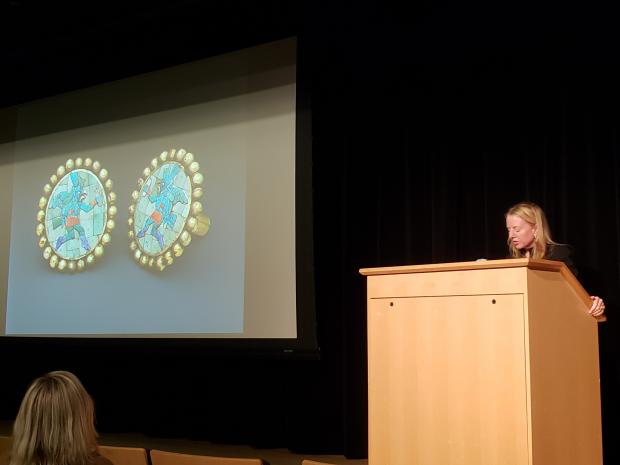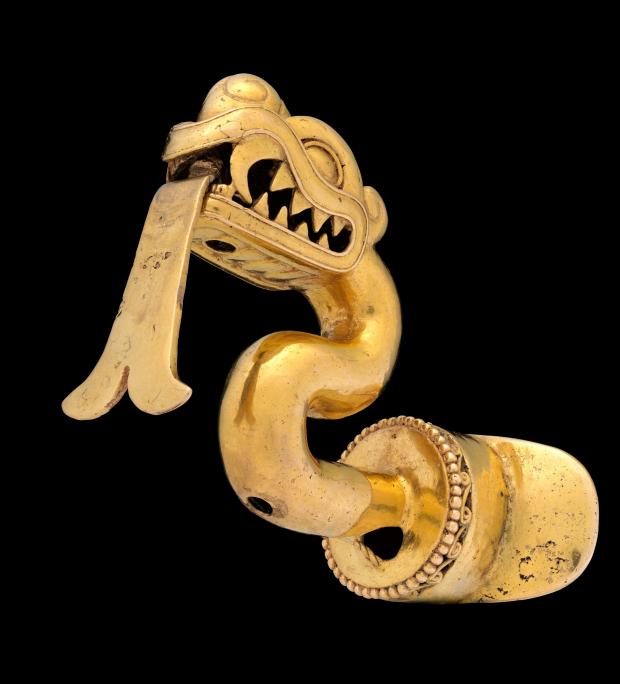Thoughts on the 15th Annual Paul and Erika Bourguignon Lecture in Art and Anthropology

A painting on display in the Metropolitan Museum captures a view of the Andes: breathtaking mountains, twisted trees, and a winding river. Without doubt, it is a beautiful view, especially to a room full of Midwesterners, many of whom might see a mountain two or three times in our whole lives. But, as Dr. Pillsbury (Andrall E. Pearson Curator of Ancient American Art, Metropolitan Museum of Art) notes, it is only a view, specifically one from a North American. It is, as she says, a view of the south from the north. Looking from the north (or from the east really, as it was the European conquistadores presenting their perceptions of South America), Indigenous peoples are adorned with the most precious of metals: gold. Surely the conquistadores would have been awestruck at the sight of so many faces sparkling under the weight of the gold jewelry.

And yet, it appears as if in many cases, the gold has been painted over. How could any sane person paint over something so valuable? As a little girl I spilled red paint all over the carpet, and, despite being far less valuable than gold, I still remember the scolding. I can’t imagine the trouble I would have been in had I painted over gold! I probably wouldn’t have survived.
Why did Indigenous South American artists paint gold? To answer that question, Dr. Pillsbury has organized Golden Kingdons: Luxury and Legacy in the Ancient Americas (on display through May 28th at the Met) and ask that we view the painting and the treasures she will share not from the north looking south, but from the south looking north; through the eyes of their makers and their consumers.
Looking north, you can see that artists painted over gold because it wasn’t as highly valued. Looking from the south to the north, you see that jade, textiles, and feather work were objects of the highest value. Jade had to be painstakingly carved. Feather work demanded that every single individual delicate feather had to be knotted around a string, and those strings had to be layered to produce a plush, substantial piece of art. To the people looking north, it was the process and the image that was valued, not merely the substance (gold) that was of ultimate value.

From the south looking north, I see an institution that was not made for women. As Dr. Pillsbury points out at the beginning of her lecture, even public speaking is not made for me--a woman. From the south looking north, I see holes in the wall of the women’s bathroom, which once held urinals instead of stalls because when it was built, women couldn’t be scientists. From the south looking north, I see women pumping breastmilk in the bathroom because there’s nowhere else for them to go. From the south looking north, I see a microphone that does not clip to Dr. Pillsbury’s dress. I see working long hours through a demanding schedule not built to accommodate the fluctuations of menstruation and morning sickness and menopause and sick kids and housework, and being talked over all the while.
From the south looking north, I see a process that began with Erika Bourguignon as our first female department chair and that leads to Kristen Gremillion today, only our second female leader. I see a department of female faculty mentors who, like the gold jewelry worn by the Indigenous people of South America, elevate their students above the mundane. From the south looking north I see a department of young women who, despite long hours and bathroom lines and makeshift lactation corners, are part of a valuable process. Dr. Pillsbury reminds us, that like jade, we are darn hard to destroy.
Melissa A. Clark
